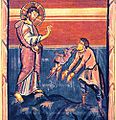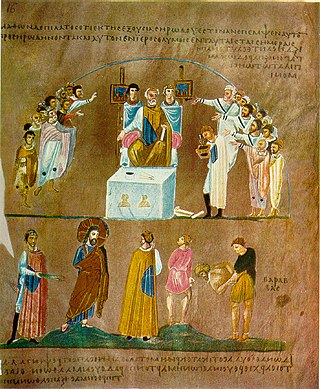
The Rossano Gospels, designated by 042 or Σ, ε 18 (Soden), held at the cathedral of Rossano in Italy, is a 6th-century illuminated manuscript Gospel Book written following the reconquest of the Italian peninsula by the Byzantine Empire. Also known as Codex purpureus Rossanensis due to the reddish-purple appearance of its pages, the codex is one of the oldest surviving illuminated manuscripts of the New Testament. The manuscript is famous for its prefatory cycle of miniatures of subjects from the Life of Christ, arranged in two tiers on the page, sometimes with small Old Testament prophet portraits below, prefiguring and pointing up to events described in the New Testament scene above.
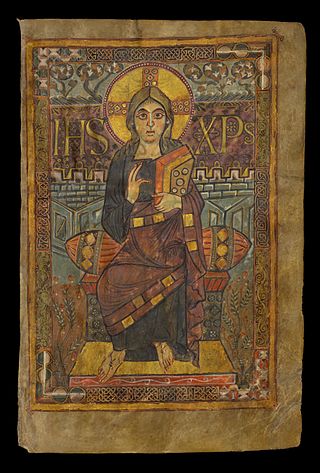
The Godescalc Evangelistary, Godescalc Sacramentary, Godescalc Gospels, or Godescalc Gospel Lectionary is an illuminated manuscript in Latin made by the Frankish scribe Godescalc and today kept in the Bibliothèque nationale de France. It was commissioned by the Carolingian king Charlemagne and his wife Hildegard on October 7, 781 and completed on April 30, 783. The Evangelistary is the earliest known manuscript produced at the scriptorium in Charlemagne's Court School in Aachen. The manuscript was intended to commemorate Charlemagne's march to Italy, his meeting with Pope Adrian I, and the baptism of his son Pepin. The crediting of the work to Godescalc and the details of Charlemagne's march are contained in the manuscript's dedication poem.

The Egbert Psalter is a medieval illuminated manuscript Psalter preserved in the municipal museum of Cividale, Italy. The psalter is an example of the illuminated manuscripts associated with the Ottonian Renaissance.

Ottonian art is a style in pre-romanesque German art, covering also some works from the Low Countries, northern Italy and eastern France. It was named by the art historian Hubert Janitschek after the Ottonian dynasty which ruled Germany and northern Italy between 919 and 1024 under the kings Henry I, Otto I, Otto II, Otto III and Henry II. With Ottonian architecture, it is a key component of the Ottonian Renaissance. However, the style neither began nor ended to neatly coincide with the rule of the dynasty. It emerged some decades into their rule and persisted past the Ottonian emperors into the reigns of the early Salian dynasty, which lacks an artistic "style label" of its own. In the traditional scheme of art history, Ottonian art follows Carolingian art and precedes Romanesque art, though the transitions at both ends of the period are gradual rather than sudden. Like the former and unlike the latter, it was very largely a style restricted to a few of the small cities of the period, and important monasteries, as well as the court circles of the emperor and his leading vassals.

The Ottonian Renaissance was a renaissance of Byzantine and Late Antique art in Central and Southern Europe that accompanied the reigns of the first three Holy Roman Emperors of the Ottonian dynasty: Otto I (936–973), Otto II (973–983), and Otto III (983–1002), and which in large part depended upon their patronage. The leading figures in this movement were Pope Sylvester II and Abbo of Fleury.
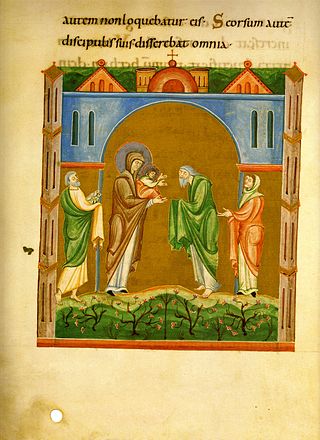
The Salzburg Pericopes is a medieval Ottonian illuminated gospel pericopes made c. 1020 at St. Peter's Monastery, Salzburg, during the reign of Henry II, the last Ottonian Holy Roman Emperor. It was made for Hartwig von Ortenburg, Archbishopric of Salzburg.
Henry Maria Robert Egmont Mayr-Harting is a British medieval ecclesiastical historian. From 1997 to 2003, he was Regius Professor of Ecclesiastical History at the University of Oxford and a lay canon of Christ Church, Oxford.
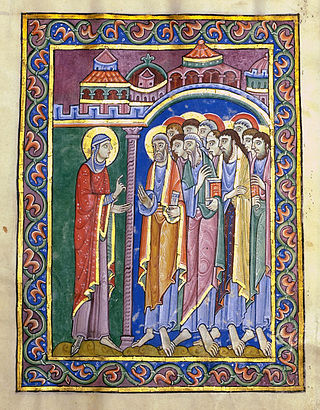
The St Albans Psalter, also known as the Albani Psalter or the Psalter of Christina of Markyate, is an English illuminated manuscript, one of several psalters known to have been created at or for St Albans Abbey in the 12th century. It is widely considered to be one of the most important examples of English Romanesque book production; it is of almost unprecedented lavishness of decoration, with over forty full-page miniatures, and contains a number of iconographic innovations that would endure throughout the Middle Ages. It also contains the earliest surviving example of French literature, the Chanson de St Alexis or Vie de St Alexis, and it was probably commissioned by an identifiable man and owned by an identifiable woman. Since the early 19th century it has been owned by the church of St. Godehard in Hildesheim, Lower Saxony in northwestern Germany, but is now stored and administered at the nearby Dombibliothek in Hildesheim Cathedral. A single leaf from the manuscript is at the Schnütgen Museum, Cologne; one further leaf, and one further cutting, are missing from the volume, their whereabouts unknown.

Egbert was the Archbishop of Trier from 977 until his death.

The Gospels of Otto III is considered a superb example of Ottonian art because of the scope, planning, and execution of the work. The book has 276 parchment pages and has twelve canon tables, a double page portrait of Otto III, portraits of the four evangelists, and 29 full page miniatures illustrating scenes from the New Testament. The cover is the original, with a tenth-century carved Byzantine ivory inlay representing the Dormition of the Virgin. Produced at the monastery at Reichenau Abbey in about 1000 CE., the manuscript is an example of the highest quality work that was produced over 150 years at the monastery.
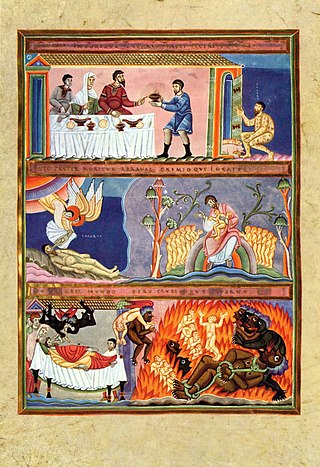
The Codex Aureus of Echternach is an illuminated Gospel Book, created in the approximate period 1030–1050, with a re-used front cover from around the 980s. It is now in the Germanisches Nationalmuseum in Nuremberg.

The Master of the Registrum Gregorii, also known as the Registrum Master or the Gregory Master, was an anonymous 10th-century scribe and illuminator, active in Trier during the episcopate of Egbert of Trier.

The Hours of Joanna I of Castile is a sixteenth-century illuminated codex housed in the British Library, London, under call number Add MS 35313.
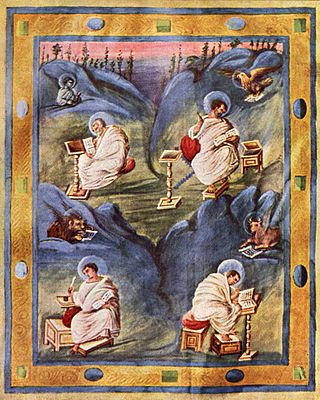
The Aachen Gospels are a Carolingian illuminated manuscript which was created at the beginning of the ninth century by a member of the Ada School. The Evangeliary belongs to a manuscript group which is referred to as the Ada Group or Group of the Vienna Coronation Gospels. It is part of the church treasury of Charlemagne's Palatine Chapel, now Aachen Cathedral, and is today kept in the Aachen Cathedral Treasury. The Treasury Gospels and the more recent Ottonian Liuthar Gospels are the two most significant medieval manuscripts on display there.

The Sacramentary of Henry II, also called the Regensburg Sacramentary, is a manuscript of liturgical texts, which was created in Regensburg at the order of Emperor Henry II. It is among the most significant works of Ottonian illumination. The manuscript was gifted to Bamberg Cathedral by Henry II, was part of the Cathedral treasury until 1803 when it became part of the Bavarian State Library as a result of Secularisation. It remains there today, stored under the inventory number clm 4456. It is modelled on the Codex Aureus of St. Emmeram donated by Charles the Bald in 870.

A presentation miniature or dedication miniature is a miniature painting often found in illuminated manuscripts, in which the patron or donor is presented with a book, normally to be interpreted as the book containing the miniature itself. The miniature is thus symbolic, and presumably represents an event in the future. Usually it is found at the start of the volume, as a frontispiece before the main text, but may also be placed at the end, as in the Vivian Bible, or at the start of a particular text in a collection.
The Sainte-Chapelle Gospels or the Sainte-Chapelle Gospel Book is an Ottonian illuminated manuscript now housed in the Bibliothèque nationale de France in Paris as Latin 8851. It is made up of 156 parchment folios, in a 38.5 cm by 28 cm format, making it one of the largest manuscripts of its era. It includes miniatures such as the canon tables, Christ in majesty and the Four Evangelists. It is the work of the Master of the Registrum Gregorii, the most famous illuminator of the Ottonian Renaissance.

The Codex Wittekindeus is a 128-folio illuminated Gospel Book, produced in Fulda Abbey in Germany around 970–980. Alongside the Gero Codex, the Codex Wittekindeus is considered one of the two "greatest works in the initial Ottonian revival of book-illumination".
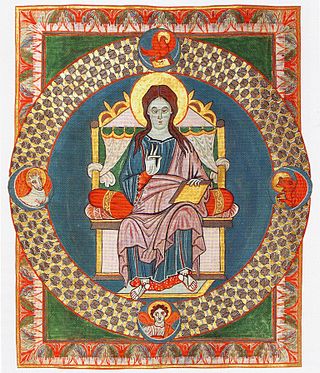
The Gero Codex or Gero-Codex is an Ottonian illuminated manuscript probably produced at Reichenau Abbey in Germany between 950 and 970. It is one of the first and most splendid of the Eburnant group of early Ottonian manuscripts.
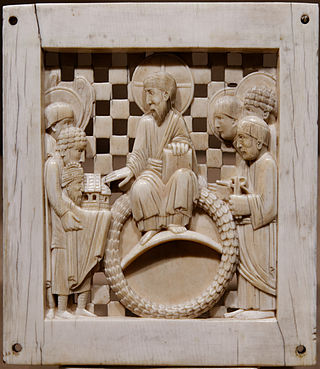
The Magdeburg Ivories are a set of 16 surviving ivory panels illustrating episodes of Christ's life. They were commissioned by Emperor Otto I, probably to mark the dedication of Magdeburg Cathedral, and the raising of the Magdeburg see to an archbishopric in 968. The panels were initially part of an unknown object in the cathedral that has been variously conjectured to be an antependium or altar front, a throne, door, pulpit, or an ambon; traditionally this conjectural object, and therefore the ivories as a group, has been called the Magdeburg Antependium. This object is believed to have been dismantled or destroyed in the 1000s, perhaps after a fire in 1049.

